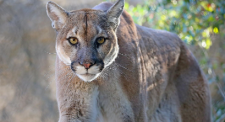Mountain lions are on the prowl and showing up more often in Kansas, biologists say.
KSNT 27 News spoke with Kansas Department of Wildlife and Parks Biologist Matt Peek about recent mountain lion sightings in the Sunflower State. As it turns out, this big cat has been spotted roaming near populated areas with greater frequency in just the past few years.
So what does this mean for Kansans and should it be a cause for concern? See below to get the full breakdown on what experts are saying about this American predator.
Mountain lions are known by many names, according to National Geographic . These include puma, cougar, catamount, panther, red tiger and deer tiger. They usually measure 1.8 to 2.4 feet in height with males coming in at three to 6.5 feet in length and 125-220 pounds while females measure out at three to 5.5 feet in length and 75-140 pounds, according to the U.S. Fish & Wildlife Service (USFWS).
The most recognizable feature of a mountain lion is its long and heavy tail which measures almost two-thirds the length of the head and body, according the USFWS. They can jump 20 feet in the air and leap distances of 40 feet horizontally. Their diets consist of a mix of small and large game and farm animals: squirrels, beavers, raccoons, coyotes, rabbits, birds, opossums, cattle, deer, pig, porcupine, elk or moose.
Sightings of these animals in Kansas, while having recently increased, are still rare. Mountain lions are also frequently mistaken for domestic cats and bobcats along with coyotes and dogs on occasion, making confirmed sightings difficult, according to the KDWP.
Recent sightings
Peek told KSNT 27 News that the KDWP has always kept tabs on mountain lion activity in the state and has noticed an increase in recent years. The first confirmed sighting of a mountain lion in modern times occurred in 2007 when one was shot and killed in Barber County. Before that, the last mountain lion documented in Kansas was killed in 1904 in Ellis County.
Peek said current evidence indicates that the mountain lions being seen in Kansas are “dispersers.” This means they are traveling through Kansas in search of a place to live, often coming from Nebraska or further north from South Dakota and the western states. The majority of these lions are young males who have to travel as staying in their home range could get them killed by an adult male. However, these big cats do not stay for long before moving on.
“What this means is in most cases when a lion has been confirmed in an area, it has moved on by the next night and is unlikely to return to that area again,” Peek said. “Some have moved hundreds of miles across the landscape, presumably in search of suitable habitat that is occupied by resident lions of the opposite sex.”
Peek released the below chart showing where confirmed mountain lion sightings have been recorded by the KDWP over the past 16 years. In total, there have been 50 since 2007 with the most recent sightings occurring in Riley County just two weeks ago, according to Peek.
Several sightings in recent times were reported by the KDWP across the state. In 2019, the KDWP reported that a dead mountain lion was found in Rooks County, prompting an investigation by state officials. In 2020, a mountain lion was caught on camera in Kiowa County making it, at the time, the 21st confirmed sighting since 2007. The sighting of another mountain lion in Wichita in 2021 brought the number to 36, indicating a sharp rise in confirmed sightings in the past three years.
“Since 2007, we’ve had over 50 mountain lion confirmations in the state,” Peek said. “This includes confirmations of some mountain lions that were documented multiple times. About half of all confirmations have occurred in the past 3 years, so there has been an increase, but there is still no evidence that resident mountain lions exist in Kansas – meaning those living and staying in an area with an established home range.”
While the number of lions seen in Kansas is increasing, Peek said this isn’t something that should be a big concern to most Kansans. Incidents where a lion is aggressive towards a human are rare in states where they are more common, according to the U.S. Geological Survey . Peek said there are precautions people can take to protect their pets and children but encounters with mountain lions are so unpredictable and rare that the precautions aren’t warranted.
“Even in cases where a lion was known to have been in Kansas, they are likely to be present in that area for a very short time, and generally keep moving across the landscape,” Peek said.
An increase in the presence of mountain lions is seen as beneficial by the USGS. A mountain lion population is considered to be an indication of a healthy ecosystm as they can help regulate prey species abundance and promote biodiversity.
Peek said mountain lions are capable of moving hundreds of miles and one that was killed in Connecticut in 2011 was confirmed to have traveled more than 1,000 miles from its home in the Black Hills of South Dakota.
Nearby Missouri has also been experiencing an increase in mountain lion sightings recently as well. The Missouri Department of Conservation confirmed four sightings of mountain lions within the first month of 2023. Like Kansas, it is believed that there is no breeding population present and the cats are simply moving through the state in search of better places to live.



